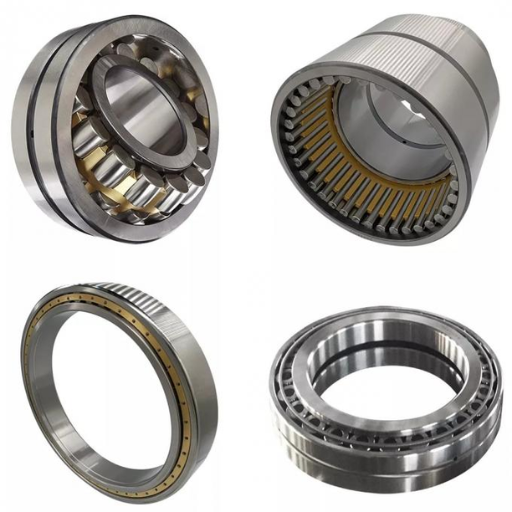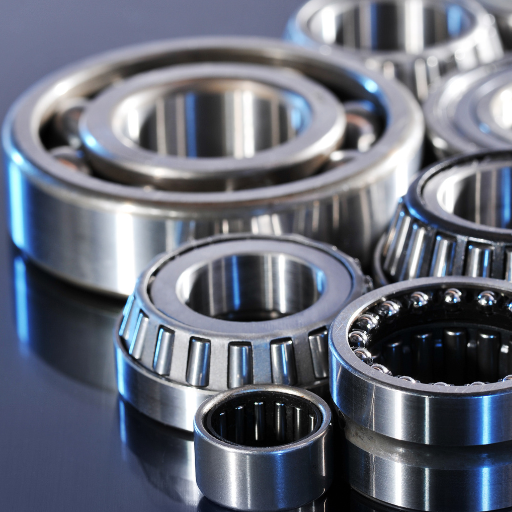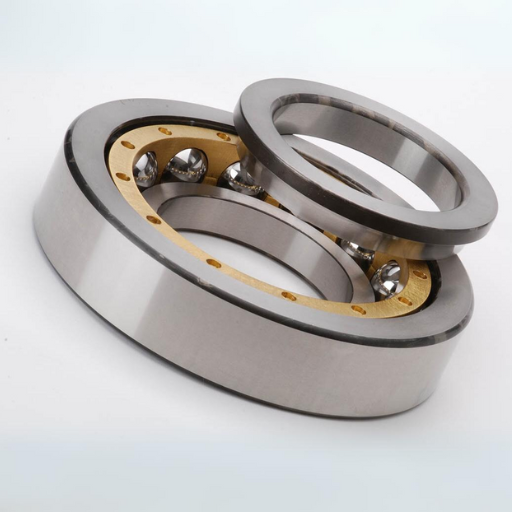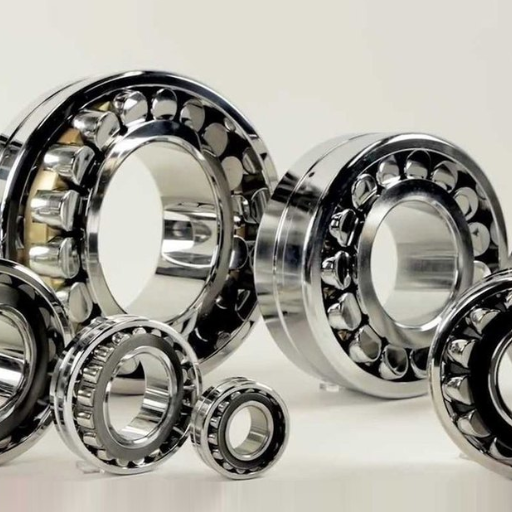Oilfield Oil and Gas
Regarding the oilfield oil and gas equipment, every component must be carefully selected to ensure maximum efficiency and reliability. That’s where Loyal comes in with their high-quality bearings designed specifically for these demanding applications. With exceptional load-bearing capacity, robustness, and precision, Loyal bearings are the go-to choice for many oil and gas industry professionals. Their products are engineered to withstand extreme temperatures, pressure, and corrosive environments, making them ideal for use in oil rigs, pipelines, and other oilfield operations. Loyal has got you covered if you’re looking for bearings that can handle the toughest conditions.

Oilfield Oil and Gas Equipment Bearing Overview
The oilfield industry is highly specialized and requires equipment that can withstand extreme conditions. One crucial component that plays a critical role in the operation of oil and gas machinery is the bearing. A bearing is a mechanical device that supports loads while reducing friction between moving parts. In an oil and gas operation, bearings are exposed to high temperatures, heavy loads, and harsh environmental conditions. They are used in equipment such as pumps, compressors, and generators. There are several types of bearings used in the oil and gas industry, including ball bearings, roller bearings, and plain bearings. The selection of the appropriate bearing depends on factors such as the operating environment, load type, and speed. Proper maintenance and lubrication are crucial for efficient and safe operation of these bearings. Understanding the various types of bearings and their applications is essential for the proper functioning of oil and gas equipment.
Types of Bearings Used in Oilfield Oil and Gas Equipment
In the oilfield and gas industry, several types of bearings are utilized to accommodate the unique demands of the equipment operating in extreme environments. The primary types of bearings found in this sector include:
- Ball Bearings are extensively used because they can support both radial and axial loads. Their low friction characteristics make them suitable for high-speed applications, such as in petroleum pumps and rotating machinery.
- Roller Bearings: Available in various designs such as cylindrical, spherical, and tapered, roller bearings are chosen for their higher load capacity. They are particularly effective in applications involving heavy loads and slow speeds, as seen in drilling rigs and winches.
- Plain Bearings (Sleeve Bearings): Composed of basic elements such as a shaft and a sleeve, plain bearings excel in applications requiring simplicity and reliability. They are often found in environments with mandatory high lubrication, such as motor outputs and non-rotating equipment.
- Thrust Bearings: Designed specifically to manage axial loads, thrust bearings are critical in operations involving rotating equipment, such as turbine systems in oil extraction and transportation.
- Magnetic Bearings: Often applied in high-precision and high-speed applications, magnetic bearings provide contactless support. Their ability to operate without lubrication makes them an ideal choice for situations where traditional lubricants may fail due to the harsh conditions often present in oilfields.
Understanding the specific functions and advantages of these bearing types is crucial for optimizing the performance and longevity of equipment used in oil and gas operations. Proper selection and maintenance contribute significantly to operational efficiency and safety.
Bearing Products for Oilfield Equipment
| Type | Bore Diameter | Outside Diameter | Width | Brand |
|---|---|---|---|---|
| 71425/71750 | 107.95 mm | 190.5 mm | 47.625 mm | Timken |
| NN3007ZTBKR | 35 mm | 62 mm | 20 mm | NSK |
| 93825/93127CD | 203.2 mm | 317.5 mm | 104.775 mm | Timken |
| 7220CG/GLP4 | 100 mm | 180 mm | 34 mm | NTN |
| NN3008ZTBKR | 40 mm | 68 mm | 21 mm | NSK |
Considerations for Bearing Installation
When installing bearings, several critical factors must be considered to ensure optimal performance and longevity of equipment, particularly in high-demand environments such as oil and gas operations. Firstly, proper alignment is paramount; misalignment can lead to uneven wear and premature failure. To verify alignment during installation, use precision instruments, such as dial indicators.
Secondly, cleanliness is essential throughout the installation process. Any particles or contaminants can compromise the integrity of the bearing, leading to increased friction and wear. Ensure all components are cleaned thoroughly before assembly.
Additionally, the correct application of lubrication is vital. Excess or insufficient lubrication can significantly affect bearing performance. Follow the manufacturer’s specifications regarding lubricant types and quantities, and consider the operational temperature and load conditions when selecting lubricants.
Lastly, employ appropriate installation techniques. Excessive force can damage bearings; therefore, utilize pressing tools to install bearings without applying undue stress. Regular inspection following installation is also advised to identify potential issues before they escalate. By adhering to these considerations, one can significantly enhance the reliability and efficiency of bearing applications.
Common Issues Encountered With Bearings During Operation
During the operational lifecycle of bearings, several issues can arise that may adversely affect performance and operational efficiency. One prevalent problem is overheating, which can occur due to inadequate lubrication, excessive load, or misalignment. Overheating reduces lubrication effectiveness, accelerates wear, and can lead to catastrophic failure if not rectified swiftly.
Another significant concern is contamination, which can be introduced through particulate matter, moisture, or improper handling. Contaminants compromise the bearing’s lubrication film, leading to increased wear, noise, and potential failure of the bearing. It is critical to implement effective sealing solutions and maintain a clean operational environment to mitigate this risk.
Fatigue failure is also a common issue in bearings subjected to fluctuating loads over extended periods. This phenomenon manifests as spalling or pitting on the raceways, ultimately resulting in loss of functionality. Monitoring load conditions and implementing regular maintenance can help recognize early signs of fatigue.
Finally, insufficient fitting tolerance can lead to fretting corrosion, especially in applications subject to vibration. This occurs when there is relative motion between the bearing and its housing, leading to small wear particles that further exacerbate the situation. Ensuring accurate fit during the installation phase can significantly reduce this risk.
Addressing these common issues through proactive maintenance strategies and adhering to best practices in bearing operation will enhance overall equipment reliability and performance.

Clearance Requirements
- Operational Temperature: Bearings in oilfield equipment can experience significant temperature fluctuations. The clearance must accommodate thermal expansion to prevent excessive loading and potential radial interference during operation.
- Load Conditions: Variations in static and dynamic load trajectories require precise clearance adjustments. Bearings subjected to heavy or fluctuating loads must be designed with appropriate clearances to allow for movement without compromising structural integrity.
- Vibration Levels: Equipment operating in oil and gas environments often experiences high levels of vibration. Adequate clearance can mitigate the risk of fretting corrosion and ensure that the bearings maintain proper alignment under such conditions.
- Lubrication Type: The choice of lubrication, whether it be grease or oil, significantly affects the required clearance. Different viscosities will lead to distinct film thicknesses; therefore, clearances must be set to achieve the desired lubrication performance.
- Environmental Factors: Exposure to contaminants like dust, water, and chemicals can influence clearance specifications. Bearings in these environments require additional considerations for clearances and sealing to maintain functionality.
- Installation Accuracy: The precision of the installation process can have profound implications on clearance. Ensuring that bearings fit correctly is crucial for maintaining the design specifications throughout the equipment’s operational life.

Sealing Requirements for Bearings in Oil and Gas Equipment
- Pressure Resistance: Bearings must be sealed adequately to withstand the often high-pressure environments found within oil and gas applications. The seals should be designed to maintain integrity under varying pressure levels, preventing the ingress of contaminants while ensuring optimal performance.
- Temperature Extremes: Given the significant thermal variations possible in oilfield operations, seals must be crafted from materials capable of withstanding high temperatures and preventing degradation. This ensures that seals do not fail under thermal stress, which could lead to lubrication loss and increased wear on bearing surfaces.
- Chemical Compatibility: The seals must exhibit resistance to various chemicals and hydrocarbons commonly encountered in oil and gas environments. Material selection is critical; elastomers, for instance, should be chosen based on their compatibility with specific fluids to prevent swelling, hardening, or degradation.
- Contaminant Exclusion: Seals must effectively exclude particulate matter, moisture, and other environmental contaminants to prolong bearings’ lifespan. This often necessitates the use of multiple sealing elements or labyrinth seals that provide additional barriers against infiltration.
- Dynamic Performance: The sealing system must accommodate the dynamic elements of the bearing assembly. As components move, seals must maintain contact without excessive drag, ensuring that they do not impede the operational smoothness while providing effective sealing functions.
- Maintenance Accessibility: Finally, the design of the sealing system should allow for ease of maintenance and replacement. Bearings in oil and gas applications are often subjected to harsh conditions, and seals may require periodic inspection or replacement to ensure reliability and longevity. Awareness of the maintenance process can significantly impact the overall operational efficiency of the equipment.
Environmental Requirements for Bearings in Oil and Gas Equipment
- Temperature Extremes: Bearings in oilfield equipment must operate effectively across a wide range of temperatures, from extreme cold to elevated heat commonly encountered in drilling and extraction processes. Components must endure thermal cycling without compromising structural integrity or performance.
- Pressure Resistance: Equipment in the oil and gas sector often experiences high-pressure conditions. Bearings must be designed to handle these pressures without deformation or failure, ensuring that the seals remain intact and operational under stress.
- Corrosive Environments: The presence of corrosive substances, including hydrogen sulfide (H2S) and various acids and salts, presents a significant challenge. Bearings and seals must be constructed from materials that resist corrosion and degradation to maintain functionality over time.
- Vibration and Shock Resistance: Equipment in the oilfield regularly encounters vibrations and shock loads. Bearings must be designed with materials and structures that can absorb and mitigate these forces, thus extending their service life and maintaining operational reliability.
- Fluid Contamination: The risk of contaminant ingress due to the presence of drilling fluids and other operational substances necessitates that bearings incorporate effective sealing solutions. This requires careful engineering to ensure that seals can withstand exposure to these contaminants without failing.
- Sealing Integrity: Given the critical nature of maintaining lubrication and preventing fluid leaks, the integrity of seals surrounding bearings is paramount. Regular monitoring and maintenance protocols should be established to evaluate seal performance and address any issues promptly.
Temperature Requirements
In oilfield operations, temperature management is crucial for the optimal performance of bearings used in various machinery and equipment. Bearings must operate effectively across a wide temperature range, typically from -40°F (-40°C) to 250°F (121°C), depending on specific application and environmental conditions. High temperatures can lead to lubrication breakdown, material degradation, and potential failure of the bearing system. Therefore, it is essential to select materials and lubricants that can withstand such thermal stress. Advanced bearing technologies, such as ceramic hybrids or specialized lubricants, may be employed to enhance thermal stability. Additionally, effective cooling methods, including heat sinks and proper ventilation systems, are critical in maintaining operational temperatures within specified limits, thereby ensuring longevity and reliability of the bearing systems in demanding oilfield environments.
Lubricant Selection
The selection of lubricants for bearings in oilfield oil and gas equipment is a critical aspect that directly influences operational efficiency and equipment longevity. The lubricant must be compatible with the specific environmental conditions of the oilfield, including the presence of contaminants such as water, dust, and various operational fluids. Additionally, the lubricant should exhibit high resistance to oxidation and thermal degradation, particularly given previously outlined operational temperature ranges.
When choosing lubricants, one must consider the viscosity index, which indicates how much the lubricant’s viscosity changes with temperature fluctuations. High-viscosity index lubricants maintain their performance across a wider range of temperatures, ensuring that the bearings remain adequately lubricated under varying thermal conditions. Moreover, additives such as anti-wear agents and corrosion inhibitors are vital to enhance the lubricant’s performance, protecting bearing surfaces from wear and tear and mitigating corrosion risks associated with harsh operating environments.
In summary, an informed lubricant selection process, accounting for environmental conditions, operational parameters, and material compatibility, is essential for optimising bearing performance in oilfield oil and gas applications. Regular assessments and adjustments to the lubrication strategy may also be required to adapt to changing conditions and maintain the bearing systems’ integrity.

Selection of Bearing Types
When selecting bearing types for oilfield oil and gas equipment, several critical factors must be considered to ensure optimal performance and reliability. Firstly, the loading conditions that the bearings will encounter are paramount; this includes both static and dynamic loads which can significantly influence bearing selection. Bearings must be capable of withstanding the specific load characteristics of the application, including radial and axial forces.
Additionally, environmental conditions play a crucial role in influencing bearing type selection. Bearings must be adept at operating in harsh environments characterized by extreme temperatures, high humidity, and potential contamination from oil, water, and dirt. The selection of materials capable of resisting corrosion and wear is thus vital, particularly in environments subject to frequent exposure to aggressive substances.
Another critical aspect is the application’s rotational speed. Different bearing types exhibit varying performance characteristics at different speeds. For example, rolling element bearings are generally preferred for high-speed applications due to their lower friction compared to sliding bearings. Conversely, sliding bearings might be more appropriate for low-speed, high-load conditions.
Furthermore, maintenance considerations, including ease of lubrication and the ability to replace bearings without extensive downtime, influence selection. Employing bearings that allow for effective maintenance protocols and timely interventions can extend the life cycle of the equipment.
In conclusion, the selection of bearing types for oilfield oil and gas equipment requires a comprehensive assessment of loading conditions, environmental factors, operational speeds, and maintenance requirements to ensure the system’s integrity and efficiency.
Bearing Life
Bearing life is significantly influenced by several key factors, each of which warrants careful consideration to enhance performance and longevity. One primary factor is the quality of lubrication. Inadequate or inappropriate lubrication can lead to increased friction and overheating, ultimately causing premature wear. To optimize this aspect, a thorough analysis of the lubricant’s viscosity and compatibility with the bearing materials is essential. Additionally, implementing a regular maintenance schedule that includes lubrication checks can mitigate the risks associated with lubrication failure.
Another critical factor is the alignment and installation of bearings. Misalignment can cause uneven load distribution, resulting in intensified wear on certain areas of the bearing surfaces. Therefore, employing precision installation techniques and utilizing alignment tools can significantly reduce the likelihood of misalignment issues.
Load capacity and the management of dynamic loads are also essential elements affecting bearing life. Bearings should be selected based on their specific load conditions during operation. Employing overload protection mechanisms can help alleviate the impact of unexpected load spikes.
Lastly, environmental considerations must not be overlooked. Protecting bearings from contaminants through the use of seals and shields will minimize exposure to harmful particles and moisture. Selecting bearings designed for specific environmental conditions can further enhance lifespan. By addressing these factors through informed selection and proactive management, the operational efficiency and durability of bearings can be significantly improved.
Basic Dynamic Load Rating and Fatigue Life
The Basic Dynamic Load Rating (C) is a crucial parameter in the selection and performance evaluation of rolling element bearings. This rating is defined as the maximum load that a bearing can theoretically endure for a specified period without experiencing fatigue failure, typically defined as 1 million revolutions under identical loading conditions. It is essential to consider that the actual load experienced by the bearing during operations should not exceed this rating to ensure reliability and longevity.
Fatigue life, commonly expressed in terms of L10 life, represents the point at which 10% of a group of identical bearings will have failed due to fatigue. This parameter is derived from the relationships between applied loads and the Basic Dynamic Load Rating. Engineers can accurately estimate the expected operational life of the bearing by conducting a detailed analysis of load scenarios and incorporating factors such as load type—static or dynamic—and operational conditions. Utilizing this data in conjunction with historical performance metrics allows for informed decisions regarding bearing selection and the implementation of preventive maintenance strategies to enhance the bearing’s functional lifespan.
Dynamic Equivalent Load
Dynamic Equivalent Load (P) is integral to assessing and applying rolling element bearings in varied operational contexts. This parameter amalgamates the effects of different load components into a single, representative load that can be compared directly against the Basic Dynamic Load Rating (C). The Dynamic Equivalent Load accounts for varying operational conditions, such as axial loads and radial loads, facilitating a more comprehensive understanding of bearing behaviour under dynamic conditions.
When calculating the Dynamic Equivalent Load, engineers must consider the nature of the applied loads—typically, these are statically applied loads, but in dynamic environments, the loads fluctuate, complicating the assessment. The standard formula for Dynamic Equivalent Load incorporates the radial and axial load components, typically expressed as follows:
P = X · Fr + Y · Fa
In this equation, Fr represents the radial load and Fa denotes the axial load. The coefficients X and Y account for the bearing’s geometry and configuration. It’s crucial to compute P accurately, as it directly impacts fatigue life calculations and overall bearing performance under operational stresses. A solid grasp of the Dynamic Equivalent Load allows industry professionals to optimize bearing selection and predict service life more precisely, ultimately enhancing system reliability and efficiency.

Basic Static Load Ratings and Static Equivalent Loads
The Basic Static Load Rating (C0) is a critical metric in bearing design that quantifies the load-carrying capacity of a rolling element bearing under static conditions. This parameter is defined as the maximum load that a bearing can sustain without experiencing significant permanent deformation of the rolling elements or raceways. Understanding the Basic Static Load Rating is paramount for engineers, particularly in applications where bearings are subject to high static loads or where operation at low speeds is prevalent.
To evaluate the suitability of a bearing for a given application, it is necessary to determine the Static Equivalent Load (P0). This simplified load parameter consolidates the effects of various static loads—including radial and axial forces—into a single value that can be compared with the Basic Static Load Rating. The Static Equivalent Load is expressed through a formula that is analogous to the one used for Dynamic Equivalent Load, taking into account the bearing’s specific geometry and load conditions.
The formula for calculating the Static Equivalent Load is represented as follows:
P0 = X * Fr + Y * Fa
In this equation, Fr represents the static radial load, while Fa indicates the static axial load. The coefficients X and Y depend on the bearing’s design characteristics, reflecting the distribution and intensity of the applied loads. The Static Equivalent Load mustn’t surpass the Basic Static Load Rating, as exceeding this limit could result in plastic deformation and premature bearing failure. Proper assessment of these parameters ensures optimal bearing performance and longevity in mechanical systems.
Bearing Tolerances
Bearing tolerances are critical specifications that dictate the permissible limits of variation in dimensional characteristics of bearings, affecting their fit and functionality in mechanical assemblies. Tolerances are categorized into several classes, which govern the clearance between the bearing components and the shaft or housing in which they operate. The common dimensional tolerances include the inner diameter (ID), outer diameter (OD), and width, and they are typically defined according to international standards such as ISO or ABEC (Annular Bearing Engineers’ Committee).
It is essential to select appropriate tolerance classes based on the operational parameters of the application, including speed, load conditions, and temperature variations. For instance, tighter tolerances are usually required in high-speed applications to minimize vibrations and increase operational precision, whereas looser tolerances may be acceptable in applications characterized by lower speeds or heavy loads.
The key aspect of interpreting bearing tolerances lies in understanding the functional fit. The fit can be classified as clearance fit, interference fit, or transition fit, which describes how snugly the bearing seats onto the shaft or inside the housing. Clearances should be appropriately calculated to account for thermal expansion and operational dynamics, ensuring that the bearing operates within optimal parameters without excessive play or undue stress, thus prolonging the lifespan and reliability of the mechanical system. Properly assessed bearing tolerances contribute significantly to the overall performance, efficiency, and effectiveness of engineering applications.
Fits and Internal Clearances
The concept of fits is integral to the functionality of bearing assemblies, as it directly impacts the interaction between the bearing and its associated components. Fits can be classified into three primary categories: clearance fit, interference fit, and transition fit. A clearance fit exists when the internal diameter of the bearing is slightly larger than the diameter of the shaft, allowing for free movement. This type of fit is commonly employed in applications where thermal expansion must be accommodated and is particularly crucial in high-speed operations where wear due to friction must be minimized.
Conversely, an interference fit results from the bearing’s internal diameter being smaller than the shaft diameter, creating a tight connection that prevents relative motion. This fit is advantageous in applications where the assembly must withstand high torque or axial loads, as it locks the components together effectively. However, the challenges posed by thermal expansion must be considered, as they can induce stress in the assembly, leading to potential failure if not properly managed.
Transition fits occupy a middle ground, providing a compromise between clearance and interference. They allow for a small degree of manipulation while still ensuring minimal play. The choice of fit is influenced by operational factors such as load magnitude, operational temperature variations, and required precision. By accurately defining internal clearances within these fitting types, engineers can optimize bearing performance, ensuring smooth operation, reducing the likelihood of failure, and enhancing the longevity of mechanical systems.
Lubrication
Proper lubrication is essential for the optimal performance and longevity of bearing assemblies. Lubricants serve several critical functions, including reducing friction between moving components, dissipating heat generated from mechanical operations, and preventing wear and corrosion. The selection of an appropriate lubricant depends on various factors, such as operational speed, load conditions, temperature variations, and compatibility with materials.
Lubrication systems can be broadly categorized into two types: grease-based and oil-based. Grease, which is a semi-solid lubricant, provides effective performance in environments where re-lubrication is challenging, as it can adhere to surfaces and remain in place over extended periods. On the other hand, oil lubricants offer superior heat dissipation and can be circulated to ensure even distribution across bearing surfaces. Methodologies such as forced lubrication systems can enhance oil delivery, ensuring adequate lubrication even under extreme operating conditions.
It is crucial to monitor lubricant conditions periodically to evaluate factors such as viscosity, contamination levels, and degradation. Regular maintenance protocols should be established to replace or replenish lubricants as necessary. Failure to maintain proper lubrication can lead to increased wear, overheating, and ultimately, premature failure of the bearing assembly, underscoring the importance of a strategic lubrication regime in engineering design.
Materials for Bearing Rings and Rolling Elements
The selection of materials for bearing rings and rolling elements is a critical aspect of bearing design, influencing both performance and durability. Typically, bearing rings are constructed from high-quality steel, specifically through hardening processes such as heat treatment, to enhance their wear resistance and fatigue strength. Commonly used materials include AISI 52100 chrome steel, which exhibits exceptional hardness and toughness, making it suitable for a variety of applications. In more specialized environments, components may be fabricated from stainless steel grades like AISI 440C, providing enhanced corrosion resistance without significantly compromising mechanical properties.
Additionally, non-ferrous materials such as ceramics and composites are gaining traction in advanced bearing applications. Ceramic materials, such as silicon nitride, are particularly notable for their low density, high hardness, and excellent thermal properties, allowing for operation in extreme temperatures and in corrosive environments. Composite materials, which combine polymers with reinforcing fibers, can also serve as alternatives, offering a balance of strength, reduced weight, and greater resilience against wear. When designing bearing systems, engineers must consider the operational conditions, including load, speed, environment, and potential exposure to chemicals, to select the most suitable material that will ensure optimal performance and longevity of the bearing assemblies.

Oilfield Oil and Gas Equipment Bearing Brand
| Bearing Brand | Bearing Models | Characteristics |
| SKF | 6200 Series, Explorer Series | High reliability, excellent load capacity, low friction, enhanced performance under varying speeds and temperatures, suitable for demanding environments. |
| Timken | Tapered Roller Bearings, Spherical Roller Bearings | Designed to handle heavy loads, superior durability through advanced metallurgy, reduced friction, and optimised design for axial and radial loads. |
| NSK | 70 Series, 80 Series | High performance and reliability, reduced noise and vibration, robust design for extended service life, suitable for both high-speed and heavy-load applications. |
| FAG | High Precision Bearings, Deep Groove Ball Bearings | Engineered for precision applications, high load carrying capacity, long service intervals, and particularly effective in harsh operational conditions. |
| HAEER | Oilfield Roller Bearings | Specifically designed for oil and gas applications, high resistance to abrasive wear, optimised for extreme pressure and temperature variations, improved operational efficiency. |
| NTN | 6200 Series, Cylindrical Roller Bearings | Excellent resistance to wear, low maintenance requirements, specifically designed for high-speed operations, and enhanced resistance to corrosion and shock loads. |
Applications of Oilfield Oil and Gas Equipment Bearing
SKF Bearings
- 6200 Series: Utilized in subsea equipment and offshore drilling applications, where reliability under extreme conditions is essential.
- Explorer Series: Applied in hydraulic systems and mud pumps, ensuring optimal performance in high-speed and variable load scenarios.
Timken Bearings
- Tapered Roller Bearings: Commonly found in drill rigs and wellhead equipment, offering superior axial loading capabilities essential for drilling operations.
- Spherical Roller Bearings: Suited for conveyors and compressors, ensuring durability and performance in high-load situations typically encountered in oil extraction.
NSK Bearings
- 70 Series: Frequently employed in subsea pipelines and oil platforms, providing reliable performance while minimizing vibration and noise.
- 80 Series: Ideal for handling heavy gearbox loads in both offshore and onshore drilling rigs, contributing to the longevity of rotating machinery.
FAG Bearings
- High Precision Bearings: Perfect for high-accuracy applications in measurement devices used in exploration and production activities.
- Deep Groove Ball Bearings: Utilized in mud pumps and drilling equipment, ensuring reliability in harsh environments and extended service intervals.
HAEER Bearings
- Oilfield Roller Bearings: Specifically designed for rotary equipment in oil extraction, providing high abrasion resistance and performance under varying pressures and temperatures.
NTN Bearings
- 6200 Series: Applied in high-speed rotating equipment used in various oilfield applications, ensuring effective corrosion resistance.
- Cylindrical Roller Bearings: Widely used in downhole tools and rotary steerable systems, suitable for high radial load applications encountered in drilling operations.
Interchangeability of Bearing Models by Brand
In the field of oil and gas extraction, the interchangeability of bearing models across different manufacturers is critical for ensuring operational efficiency and reducing downtime during maintenance. Below is a detailed comparison of select bearing models from various brands, highlighting their compatibility and interchangeability.
Tapered Roller Bearings
- NSK 70 Series: Can often be interchanged with FAG 320 Seriesdue to similar dimensional specifications and load capacity.
- NTN 320 Series: Compatible with FAG 313 Series, providing a suitable alternative for axial loading applications.
Spherical Roller Bearings
- FAG 223 Series: Interchanges with NTN 230 Series, offering comparable performance in high-load scenarios typical of oil extraction operations.
Deep Groove Ball Bearings
- NSK 68 Series: Often used interchangeably with FAG 6000 Series, providing reliable operation in mud pumps.
- NTN 6900 Series: Can serve as an alternative to FAG 6200 Series, ensuring reliable performance under similar load conditions.
Cylindrical Roller Bearings
- FAG NU Series: Interchangeable with NSK NJ Series, both of which are appropriate for high radial load applications in downhole tools.
Oilfield Roller Bearings
- HAEER V Series: Designed similarly to NTN R Series, allowing cross-utilization in rotary equipment under varying environmental conditions.
In conclusion, understanding the interchangeability and compatibility of bearing models is paramount for optimizing the performance and reliability of oilfield equipment used in the oil and gas industry. Our company, Loyal, is committed to providing high-quality bearing solutions that enhance operational efficiency while minimizing maintenance interruptions. By selecting the appropriate bearing models tailored to specific applications, we ensure that our customers can operate with confidence, knowing their equipment is supported by robust and reliable components.
UCTH213-40J-300 with Setscrew(inch)
CNSORDERNO: Normal-duty(2)
TOGN: UCTH213-40J-300
SDI: B-R1/8
SD: 2 1/2
UCTH212-39J-300 with Setscrew(inch)
CNSORDERNO: Normal-duty(2)
TOGN: UCTH212-39J-300
SDI: B-R1/8
SD: 2 7/16
UCTH212-38J-300 with Setscrew(inch)
CNSORDERNO: Normal-duty(2)
TOGN: UCTH212-38J-300
SDI: B-R1/8
SD: 2 3/8
UCTH212-36J-300 with Setscrew(inch)
CNSORDERNO: Normal-duty(2)
TOGN: UCTH212-36J-300
SDI: B-R1/8
SD: 2 1/4
UCTH211-35J-300 with Setscrew(inch)
CNSORDERNO: Normal-duty(2)
TOGN: UCTH211-35J-300
SDI: B-R1/8
SD: 2 3/16
UCTH211-34J-300 with Setscrew(inch)
CNSORDERNO: Normal-duty(2)
TOGN: UCTH211-34J-300
SDI: B-R1/8
SD: 2 1/8


















